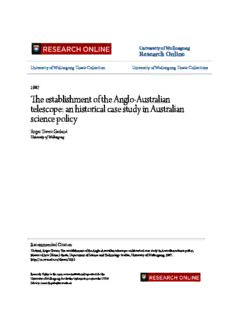
The establishment of the Anglo-Australian telescope PDF
Preview The establishment of the Anglo-Australian telescope
University of Wollongong Research Online University of Wollongong Thesis Collection University of Wollongong Thesis Collections 1987 The establishment of the Anglo-Australian telescope: an historical case study in Australian science policy Roger Trevor Garland University of Wollongong Recommended Citation Garland, Roger Trevor, The establishment of the Anglo-Australian telescope: an historical case study in Australian science policy, Master of Arts (Hons.) thesis, Department of Science and Technology Studies, University of Wollongong, 1987. http://ro.uow.edu.au/theses/2232 Research Online is the open access institutional repository for the University of Wollongong. For further information contact the UOW Library: [email protected] THE ESTABLISHMENT OF THE ANGLO-AUSTRALIAN TELESCOPE. AN HISTORICAL CASE STUDY IN AUSTRALIAN SCIENCE POLICY. A thesis submitted in partial fulfilment of the requirements for the award of the degree of MASTER OF ARTS (HONOURS) from THE UNIVERSITY OF WOLLONGONG by ROGER TREVOR GARLAND Bachelor of Science (University of Sydney) . DEPARTMENT OF SCIENCE AND TECHNOLOGY STUDIES 1987 i CONTENTS Contents i Abbreviations iii Abstract iv CHAPTER 1 INTRODUCTION 1 The trend towards a large optical telescope in Australia Notes and references 5 CHAPTER 2 AUSTRALIAN ASTRONOMY AND SCIENCE 6 2. 1 What is Australian astronomy ? 1 2. 1 . 1 Background 1 2. 1 . 2 Funding 13 2.2 Australian optical astronomy and 16 the high civilization principle. 2. 2. 1 Sky watching 16 2.2.2 Astronomy in Australia 18 1788-1900 2.2.3 Australian Astronomy in 24 the 20th century 2.3 Australian science policy in the 41 1950s and 1960s. Notes and references 47 CHAPTER 3 THE ANGLO-AUSTRALIAN TELESCOPE 52 PROJECT 1950s-DECEMBER 1962 3. 1 Introduction 52 3.1.1 The need for a large 52 southern telescope 3.1.2 A big science project 54 3.2 Advocacy, debate and delay; 63 trying to get the show on the road Notes and references 100 ii CHAPTER 4 THE ANGLO-AUSTRALIAN TELESCOPE 105 PROJECT JANUA1V- 1963-0CTOBER 197 4 4 • 1 Procrastination, further debate 106 and alternative proposals January 1963 - May 1967 4.2 Organisation, resolution and 148 construction - building the telescope May 1967 - October 1974 Notes and references 159 CHAPTER 5 CONCLUSION 168 Notes and references 183 APPENDIXES 184 Appendix I The players 185 Appendix II Prominent committees 194 Appendix III Key events 198 BIBLIOGRAPHY 204 Manuscripts 205 Published material 209 iii ABBREVIATIONS AAO Anglo-Australian Observatory AAT Anglo-Australian Telescope Academy Australian Academy of Science ANU Australian National University ANZAAS Australia and New Zealand Association for the Advancement of Science APGC Astronomy Policy and Grants Committee (UK ) [within the SRC's Astronomy, Space and Radio Board] BCSO British Commonwealth Southern Observatory CSIR Council for Scientific and Industrial Research CSIRO Commonwealth Scientific and Industrial Research Organization DSIR Department of Science and Industrial Research (UK) ESQ European Southern Observatory JPC Joint Policy Committee Royal Royal Society of London (UK) Society SRC Science Research Council (UK) iv ABSTRACT This thesis examines the establishment of the Anglo Australian Telescope as a case study in Australian science policy. An historical overview of Australian astronomy is developed, followed by an historical account of the telescope project. The latter forms the major part of the work. Attention is paid to the arguments put forward by the astronomical community to justify funding. The role of the Australian Academy of Science as an elite science institution in the decision making process is examined. Also considered is the impact in the 1960s of emerging government science policy machinery. The entrenchment of a high civilisation principle used to rationalise the professional activities of astronomers is also investigated. Cone lus ions are drawn about the complex nature of decision making processes, how decision making in science was affected by a changing context of science policy formation, and the likelihood of a joint astronomy project being undertaken in Australia in the 1980s. 1 CHAPTER 1 INTRODUCTION ":4 2 "astronomers are a queer and quarrelsome lot and unblushingly push their own interests." Marcus Oliphant [1] CHAPTER 1: INTRODUCTION The trend towards a large optical telescope in Australia The quest for larger and larger optical telescopes in Australia has featured regularly in Australian astronomical work. From the establishment of the first astronomical observatory by Governor Sir Thomas Brisbane in Parramatta in 1821, requests were made to improve facilities by increasing telescopic power. Over the years, such facilities were indeed developed, firstly by the colonies and later by the Federal Government. In the 1950s, the cyclical claims by astronomers for bigger and better telescopic power were again made. This time, the request was for a major telescope of gigantic optical proportions. However, it was not until the mid- 1960s that funds were made available for a truly major venture and only then after nearly ten years of active lobbying. The outcome was a joint Anglo-Australian facility. This thesis is located within the field of science and technology studies. In developing a perspective on science policy formation it constructs an historical account of the process followed in the establishment of a 3 large optical telescope in Australia. Included in this approach is an exploration of some of the political interactions between the institutions, philosophies and individuals involved. The general issues in science policy thus arising relate to: 1. the role of elite scientific groups 2. the development of 'big science' projects 3. competition between nations, scientific disciplines and individuals involving prestige, political expediency and world-views (including a pure science philosophy and the high civilisation principle). While a number of historical accounts of the establishment of the telescope exist [2], there has been little interpretation and analysis of the circumstances that gave rise to support for the project, nor the political interactions underpinning the actions of institutions and individuals involved. Several specific themes emerge relating to the issues listed above. Within the context of broad changes in Australian science policy during the 1950s-1960s these include: 1. the role of the Australian Academy of Science as an elite science institution
Description: